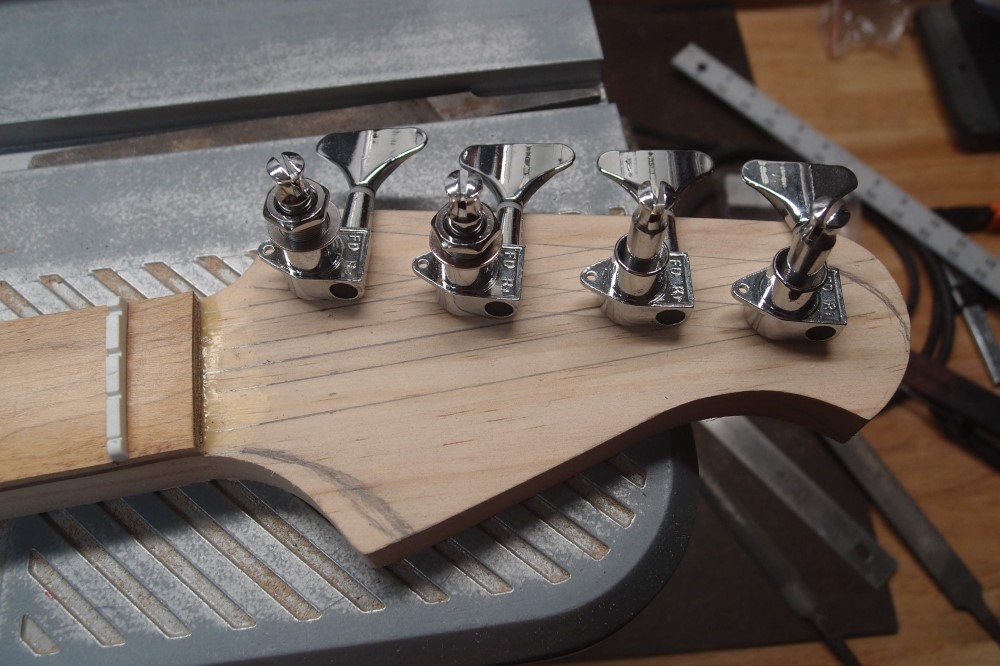Cowbell Bass Guitar (4/8)
I re-contoured the body slightly for that all-important high fret access that everyone must have but doesn't use.
First, I took the nut off and widened the hole with one of those old-style Exacto knives with a long skinny blade. For once I'm glad this isn't real maple, this western maple carved pretty easily.
When I had enough side clearance, I switched to a small drill bit, keeping it clear of the threaded rod. When I was sure the brass block had a clear path out, I extracted the rod using its own nut with progressively more spacers under the head. The beauty of this truss rod design is that all the bulk is at one end, the rest is smooth and skinny.
The rod came out surprisingly easily, but not surprisingly without its shrink-wrap covering, which was glued into the slot. That had to come out too, so I straightened a coat hanger, put a small hook in the end, chucked it in the drill, and snaked out the truss rod channel like a plumber. At the very end, I couldn't hook the last bit out, so I cut the hook off and used the sharp end to pulverize it. I put some new shrink tubing on the truss rod, which slides in and out easily now.
I filed the neck opening a bit to accept the rod upside-down, stuck the rod in, and cranked a nice front-bow into the neck. No more waiting, now I can put that Ric back together. In six months, I may have to pull the rod and flip it, or maybe just back it off a bit. Eventually, it will settle down, one way or the other. Shouldn't have to do this more than once, that's acceptable to me.
This is awesome - I'll never build a complicated double-acting rod again, and routing the neck for a removable truss rod is actually easier. In hindsight, I don't know why you'd want to permanently bury the truss rod any more than you'd want to permanently bury the tuners or the electronics. It's bad planning and bad design.
Dec 28, 2018

Wired up the electronics module. This part is pretty neat. A piece of dry-erase scrap holds the controls, output jack, battery box, and active circuitry, all in a single assembly. The volume knob is furthest, with a push/pull switch for passive/dead battery mode. Next to that is a standard tone control that works in active or passive modes. Finally, there is an active bass booster, leftover from a Squier-bodied project from several years ago. The tape-wrapped component is one of my homemade impedance buffers. For testing, I have temporarily soldered in a button piezo, and everything works, which is always a plus. The battery box is actually glued in for reinforcement, and the output jack is offset to fit my headphone amp. All of this is from the parts/junk box.

It's a tight fit in the end of the body. I also had to leave room for mounting bosses at the ends and in the center. I really couldn't fit anything else in here. The knobs are fully enclosed, even the pull switch. Not too many designs lend themselves to this sort of installation. In fact, I think this is the only one. This will get a strap button at either end, so it will stand on its own.
The two salvage Rics came out better than expected, so I ordered some good strings for both of them, and a high-mass bridge for the big one. That is just an easy way to bolt on some extra weight at the tail end, I have no belief that it affects the tone, sustain, or anything. I also got a special set of strings for this build.




Finally, I cut down the thickness the same way as before. The router pulled a small chip out of the maple. Maple is always a problem with a router, try to avoid it. I was rounding over the end of the fretboard, so I just rounded it more. I like the look. I left this headstock a little thick. The pine is so light, I have to keep telling myself it is stronger and harder than poplar, and poplar will do.
It is now shrunk down to about guitar-size, which I like. Also, I got rid of the glued-on piece at the top. Little orphans like that never look good. I can't make out the lower glue line. Frets and side markers next.










